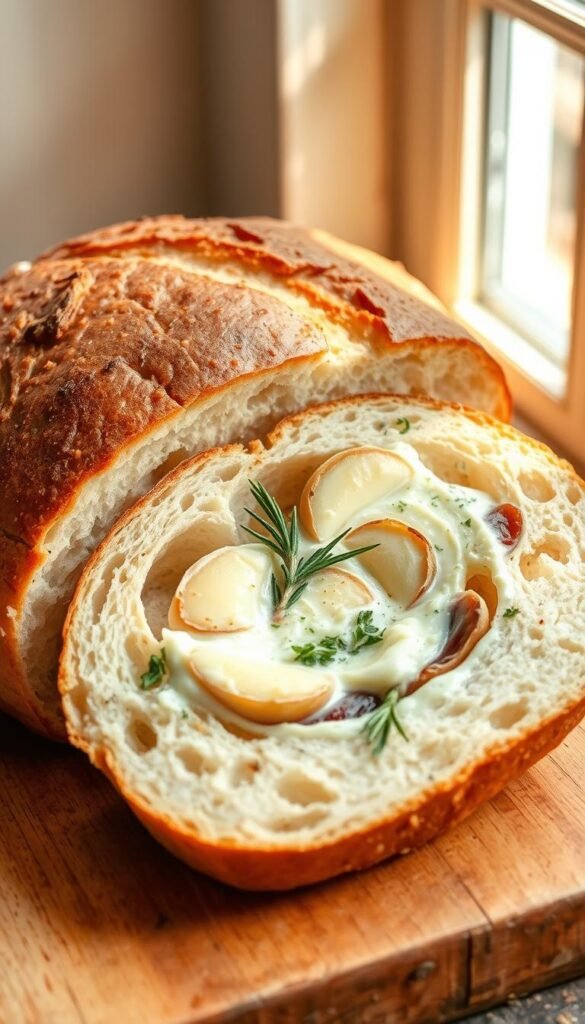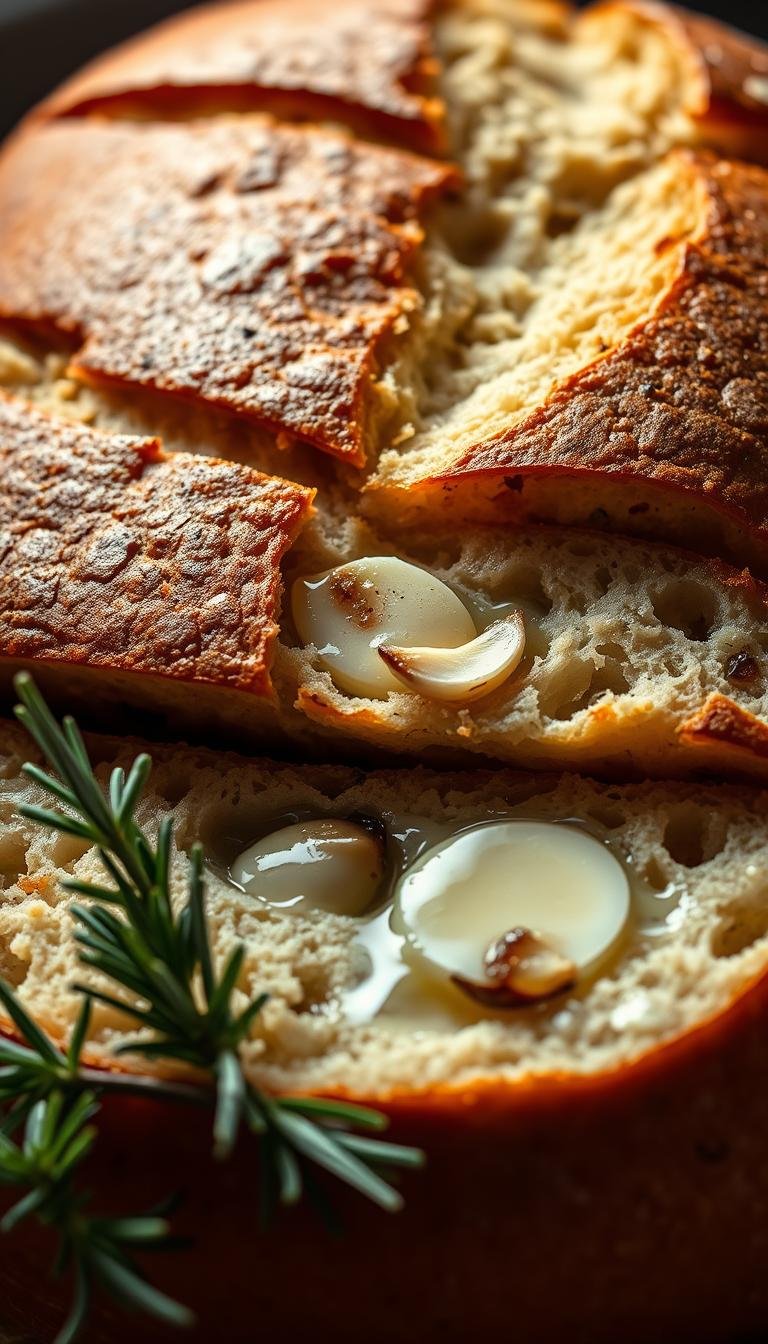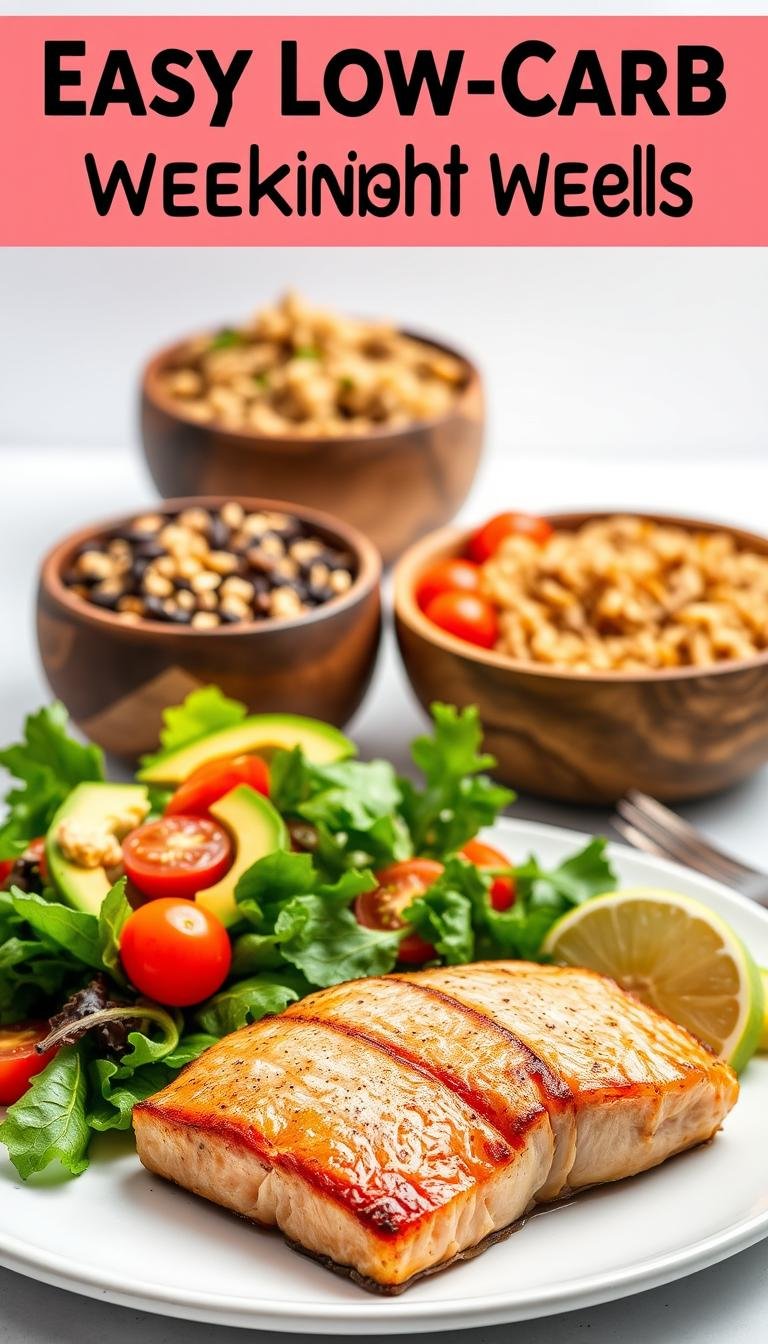6 Sourdough Garlic Bread Recipes Packed with Flavor
Imagine sinking your teeth into a crispy, aromatic loaf of sourdough garlic bread, its tangy flavor perfectly balanced by the richness of garlic. This beloved comfort food has captured the hearts of many, and for good reason – it’s a versatile canvas for a variety of flavors and ingredients.
Our comprehensive guide explores six delicious artisan bread recipes that elevate this classic to new heights. From traditional garlic butter to creative variations with cheese, herbs, and spices, these recipes offer something for every bread enthusiast. Whether you’re a seasoned sourdough baker or just starting out, you’ll find the perfect inspiration to create mouthwatering homemade garlic bread that will impress your family and friends.
Key Takeaways
- Discover six unique sourdough garlic bread recipes to try at home.
- Learn tips for achieving the perfect balance of sourdough and garlic flavors.
- Explore creative variations of garlic bread with various ingredients.
- Understand the basics of sourdough bread making and troubleshooting.
- Find inspiration for your next bread baking project.
The Magic of Sourdough Garlic Bread
The magic of sourdough garlic bread lies in its complex flavor profile, which is developed through the slow fermentation of wild yeast. This natural process not only enhances the bread’s taste but also its texture and digestibility.
Why Sourdough Makes the Best Garlic Bread
Sourdough’s unique characteristics make it an ideal base for garlic bread. The tangy, slightly acidic nature of sourdough provides a perfect counterbalance to the rich, aromatic qualities of garlic and butter. This balance creates a more nuanced taste experience than conventional bread. Moreover, the chewy texture and substantial crust of sourdough create the ideal structure for holding garlic butter and other flavorings.
The fermentation process involved in making sourdough contributes to its distinctive flavor. Wild yeast fermentation produces compounds that enhance the bread’s flavor profile, making it more complex and interesting. This complexity is a key factor in why sourdough is considered superior for garlic bread.
Essential Equipment for Sourdough Garlic Bread
To successfully make sourdough garlic bread, you’ll need some essential equipment. Here’s a breakdown of the necessary tools:
| Equipment | Purpose |
|---|---|
| Digital Scale | Precise measurements for ingredients |
| Dutch Oven | Creates steam during baking for a crispy crust |
| Bench Scraper | Handles dough during preparation |
| Proofing Basket | Allows for proper fermentation |
| Scoring Tool | Creates a professional finish on the bread |
Investing in these artisan bread tools will significantly improve your sourdough garlic bread making experience. Each piece of equipment plays a crucial role in achieving the desired flavor and texture.
Sourdough Basics for Perfect Garlic Bread
Creating perfect sourdough garlic bread begins with understanding the fundamentals of sourdough baking. A strong foundation in sourdough basics is crucial for producing bread that is not only delicious but also has the right texture and structure.
Understanding Your Sourdough Starter
A healthy sourdough starter is the backbone of any great sourdough bread. To maintain a thriving starter, it’s essential to understand its needs. Regular feeding is crucial, as it keeps the microorganisms that make your bread rise active and healthy. The frequency of feeding depends on the starter’s maturity and the environment it’s kept in. Recognizing when your starter is at its peak activity is vital; this is when it’s most potent and ready to leaven your bread effectively.
Observing your starter’s behavior and adjusting your care routine accordingly will help you achieve consistent results. A mature starter will have a tangy aroma and be bubbly, indicating that it’s ready for baking.
Fermentation Tips for Flavorful Bread
Fermentation is a critical process in sourdough bread making, directly impacting the flavor and texture of your garlic bread. Bulk fermentation timing is key; it allows the dough to develop complex flavors and a chewy texture. Temperature considerations are also important, as warmer temperatures can speed up fermentation, while cooler temperatures slow it down.

Recognizing proper dough development is crucial. The dough should be smooth, elastic, and have a slightly sour smell. These signs indicate that your bread is on its way to being flavorful and aromatic.
Choosing the Right Garlic for Your Bread
The type of garlic you use can significantly impact the flavor of your sourdough garlic bread. Fresh garlic provides a pungent flavor, while roasted garlic offers a sweeter, deeper taste. Garlic powder is another option, providing a convenient way to add garlic flavor without the texture of fresh garlic.
Understanding how different garlic preparations affect the final product is essential. Mincing garlic releases its oils and intensifies its flavor, while roasting garlic mellows out its taste, creating a rich, savory flavor profile.
Classic Sourdough Garlic Bread with Fresh Herb Butter
Get ready to elevate your bread game with our Classic Sourdough Garlic Bread, infused with the freshness of herbs in every bite. This timeless recipe combines the tanginess of sourdough with the richness of garlic and the brightness of fresh herbs, making it a perfect accompaniment to a variety of meals.
Ingredients List
To make this delicious bread, you’ll need the following ingredients:
- 1 cup sourdough starter (active and bubbly)
- 3 cups bread flour
- 1 tsp salt
- 1 tsp sugar
- 1 cup warm water
- 3 cloves garlic, minced
- 1/2 cup unsalted butter, softened
- 2 tbsp fresh parsley, chopped
- 1 tbsp fresh thyme, chopped
- 1 tbsp fresh rosemary, chopped
For those with dietary restrictions, consider substituting bread flour with a gluten-free alternative or using vegan butter.
| Ingredient | Quantity | Substitution |
|---|---|---|
| Sourdough Starter | 1 cup | Commercial yeast (1 packet) |
| Bread Flour | 3 cups | Gluten-free flour blend |
| Unsalted Butter | 1/2 cup | Vegan butter |
Step-by-Step Preparation
Creating this Classic Sourdough Garlic Bread involves several steps, starting with preparing the sourdough dough.
- Mix the sourdough starter, bread flour, salt, sugar, and warm water in a large bowl until a shaggy dough forms.
- Knead the dough for 10 minutes until it becomes smooth and elastic.
- Place the dough in a greased bowl, cover it, and let it rise in a warm place for 4-6 hours, or until doubled in size.
- Preheat your oven to 375°F (190°C).
- Shape the dough into a loaf and place it on a baking sheet lined with parchment paper.
- Bake the bread for 25-30 minutes, or until golden brown.
While the bread is baking, prepare the Fresh Herb Butter by mixing softened butter, minced garlic, chopped parsley, thyme, and rosemary in a bowl.

Serving Suggestions and Variations
Once the bread is baked and cooled slightly, spread the Fresh Herb Butter generously on top. This bread is perfect for serving alongside soups, pasta dishes, or as a side to your favorite meals.
Consider variations like adding Parmesan cheese to the butter for an extra savory flavor or incorporating sun-dried tomatoes into the dough for a Mediterranean twist.
- Pair with tomato soup for a comforting meal.
- Serve alongside spaghetti Bolognese for an Italian-inspired dinner.
- Add sun-dried tomatoes to the dough for a flavorful variation.
Roasted Garlic and Parmesan Sourdough Bread
Take your sourdough to the next level with the deep, nutty flavor of roasted garlic and the salty kick of Parmesan. This recipe elevates the classic garlic bread by incorporating roasted garlic and Parmesan directly into the sourdough dough, creating a more complex and integrated flavor profile.

Ingredients List
To make this delicious bread, you’ll need the following ingredients:
- 1 cup sourdough starter (active and bubbly)
- 3 cups bread flour
- 1 tsp salt
- 1/4 cup roasted garlic (mashed)
- 1/2 cup Parmesan cheese (grated)
- 1 tbsp olive oil
- 1 tsp dried rosemary (optional)
Selecting the right garlic and Parmesan is crucial. Choose firm, plump garlic heads for roasting, and high-quality Parmesan for the best flavor.
Step-by-Step Preparation
Roasting garlic is a simple process that brings out its natural sweetness. To roast garlic, preheat your oven to 400°F (200°C). Cut the top off a whole garlic head, drizzle with olive oil, and wrap in foil. Roast for 30-40 minutes, or until the garlic is tender and mashed. Let it cool.
Once your garlic is roasted and mashed, it’s time to mix the dough. Combine the sourdough starter, bread flour, salt, roasted garlic, and Parmesan in a mixing bowl. Mix until just combined, then let it rest for 10 minutes. After the rest, add olive oil and mix until the dough comes together. If using rosemary, fold it into the dough during the final stages of mixing.
Folding techniques are crucial for evenly distributing the ingredients without overworking the dough. Gently fold the dough over itself several times during the bulk fermentation phase to ensure the roasted garlic and Parmesan are evenly distributed.
Serving Suggestions and Variations
This Roasted Garlic and Parmesan Sourdough Bread is perfect for serving alongside Italian soups like minestrone or as an accompaniment to charcuterie boards. For variations, consider adding different herbs like thyme or oregano, or incorporating other aged cheeses for unique flavor combinations. You can also add a spicy kick with some black pepper.
As Mark Weinberg, a renowned baker, once said,
“The key to great bread is not just in the ingredients, but in the love and care you put into making it.”
This recipe is sure to become a favorite, with its rich flavors and satisfying texture.
Caramelized Onion and Garlic Sourdough Focaccia
Transform your baking with a caramelized onion and garlic sourdough focaccia recipe that combines traditional Italian flavors with a tangy twist. This delightful bread is perfect for serving alongside soups, as part of an antipasto platter, or as a base for gourmet sandwiches.

Ingredients
To make this delicious focaccia, you’ll need the following ingredients:
- 1 cup sourdough starter (active and bubbly)
- 3 cups bread flour
- 1 tsp salt
- 1 tbsp olive oil
- 1 large onion, thinly sliced
- 3 cloves garlic, minced
- 1 tsp dried rosemary (optional)
- 1/2 cup extra-virgin olive oil for drizzling
Choosing the right onions is crucial; sweet onions like Vidalia or Maui onions caramelize beautifully due to their high sugar content. For the garlic, using a combination of roasted and raw garlic can add depth to the flavor.
Step-by-Step Preparation
Preparing the caramelized onion and garlic sourdough focaccia involves several steps, starting with caramelizing the onions.
- Heat a couple of tablespoons of olive oil in a large skillet over medium-low heat. Add the sliced onions and cook, stirring occasionally, until they are deep golden brown and caramelized, about 30-40 minutes.
- While the onions are cooking, mix the sourdough starter, bread flour, salt, and 1 tbsp olive oil in a bowl until a shaggy dough forms.
- Once the onions are done, let them cool slightly before adding them to the dough along with the minced garlic. Mix until just combined.
- Knead the dough on a floured surface for about 10 minutes until it becomes smooth and elastic.
- Place the dough in a lightly oiled bowl, cover, and let it rise in a warm place until doubled in size, about 4-6 hours.
- Preheat your oven to 425°F (220°C). Punch down the dough and transfer it to a baking sheet lined with parchment paper. Dimple the dough with your fingers, creating pockets for the olive oil.
- Drizzle the dough with extra-virgin olive oil and sprinkle with dried rosemary if using.
- Bake for 20-25 minutes, or until the focaccia is golden brown and sounds hollow when tapped.
Serving Suggestions and Variations
This caramelized onion and garlic sourdough focaccia is incredibly versatile. Serve it as is, or get creative with toppings and accompaniments:
- Use it as a base for sandwiches, topped with cured meats, cheeses, and fresh greens.
- Pair it with soups or stews for a hearty meal.
- Add some Mediterranean flair by topping with olives, artichoke hearts, or sun-dried tomatoes before baking.
- For a different twist, try adding some chopped fresh herbs like thyme or oregano to the dough.
By incorporating caramelized onions and garlic into a sourdough focaccia, you create a flavorful and aromatic bread that’s sure to impress. Whether you’re serving it as a side or using it as a base for other dishes, this recipe is a great way to explore the versatility of sourdough baking.
Spicy Jalapeño and Roasted Garlic Sourdough Loaf
For those who dare to ignite their taste buds, the Spicy Jalapeño and Roasted Garlic Sourdough Loaf is a game-changer. This bold recipe combines the heat of jalapeños with the mellow sweetness of roasted garlic, creating a truly unique sourdough experience.
Ingredients List
To make this spicy sourdough loaf, you’ll need the following ingredients:
- 1 cup sourdough starter (active and bubbly)
- 3 cups bread flour
- 1 tsp salt
- 2 large jalapeños, seeded and chopped
- 4 cloves roasted garlic, minced
- 1 tbsp olive oil
- 1 tsp sugar
| Ingredient | Quantity |
|---|---|
| Sourdough Starter | 1 cup |
| Bread Flour | 3 cups |
| Jalapeños | 2 large |
| Roasted Garlic | 4 cloves |
Step-by-Step Preparation
Preparing this loaf involves several steps, starting with roasting the garlic and preparing the jalapeños.
Step 1: Roasting Garlic – Preheat your oven to 400°F (200°C). Cut the top off a whole head of garlic, drizzle with olive oil, and wrap in foil. Roast for 30-40 minutes until soft and caramelized.
Step 2: Preparing Jalapeños – Depending on your desired heat level, you can either include or exclude the seeds and membranes of the jalapeños. Chop the jalapeños and sauté them lightly to bring out their flavor.
Step 3: Mixing the Dough – Combine the sourdough starter, flour, salt, chopped jalapeños, and roasted garlic in a mixing bowl. Mix until a shaggy dough forms, then let it rest before kneading.
Step 4: Kneading and Proofing – Knead the dough for 10 minutes until it becomes smooth and elastic. Place it in a greased bowl, cover, and let it proof in a warm place until doubled in size.
Serving Suggestions and Variations
This Spicy Jalapeño and Roasted Garlic Sourdough Loaf is perfect for serving alongside chili or Mexican-inspired soups. It can also be used as a base for a gourmet grilled cheese sandwich.
Variations: For an extra kick, consider adding more jalapeños or using hotter peppers like habaneros. You can also add cheese like pepper jack or cheddar to complement the spice. For a Southwestern twist, incorporate some corn into the dough.
Mediterranean Olive and Garlic Sourdough Bread
Inspired by the sun-kissed shores of the Mediterranean, this sourdough bread brings together the bold flavors of olives and garlic in a deliciously crusty loaf. The combination of briny olives and aromatic garlic creates a truly unforgettable taste experience.
Ingredients List
To make this Mediterranean-inspired sourdough, you’ll need the following ingredients:
- 1 cup sourdough starter (active and bubbly)
- 2 cups bread flour
- 1/2 cup whole wheat flour
- 1/2 cup water
- 1/4 cup extra-virgin olive oil
- 1/2 cup pitted and chopped olives (Kalamata or Castelvetrano work well)
- 3 cloves garlic, minced
- 1 tsp salt
- 1 tsp dried oregano
| Ingredient | Quantity | Notes |
|---|---|---|
| Sourdough Starter | 1 cup | Active and bubbly |
| Bread Flour | 2 cups | High-protein flour recommended |
| Whole Wheat Flour | 1/2 cup | Adds depth and nutrition |
Step-by-Step Preparation
Preparing this Mediterranean olive and garlic sourdough involves a few key steps:
- Begin by mixing the sourdough starter, bread flour, whole wheat flour, and water in a large bowl until just combined.
- Add the olive oil, chopped olives, minced garlic, salt, and dried oregano. Mix until the dough comes together in a shaggy mass.
- Knead the dough for 10 minutes, either by hand or using a stand mixer with a dough hook attachment, until it becomes smooth and elastic.
- Place the dough in a lightly oiled bowl, cover it with plastic wrap or a damp towel, and let it rise in a warm, draft-free place for 4-5 hours, or until it has doubled in size.
- Preheat your oven to 425°F (220°C). Shape the dough into a round or oblong loaf and place it on a baking sheet lined with parchment paper.
- Bake for 35-40 minutes, or until the bread is golden brown and sounds hollow when tapped on the bottom.
Serving Suggestions and Variations
This Mediterranean olive and garlic sourdough is incredibly versatile. Serve it alongside olive oil for dipping, or use it as the base for bruschetta topped with diced tomatoes and fresh basil. You can also pair it with a mezze platter featuring hummus, tabbouleh, and grilled halloumi.
For variations, consider adding other Mediterranean flavors such as artichoke hearts, sun-dried tomatoes, or crumbled feta cheese to the dough. You can also experiment with different types of olives or add a sprinkle of sumac on top of the loaf before baking for extra flavor and color.
6 Sourdough Garlic Bread Recipes Packed with Flavor
Sourdough takes center stage in our Cheesy Garlic Pull-Apart Bread, a recipe that’s as delicious as it is interactive. This bread combines the tangy complexity of sourdough with generous amounts of garlic and cheese, making it an irresistible sharing experience.
Cheesy Garlic Pull-Apart Sourdough Bread Recipe
The pull-apart bread technique is a game-changer for gatherings and parties. By shaping individual portions that bake together into a cohesive whole, you create a bread that’s both visually appealing and fun to eat. Sourdough makes an excellent base for this style due to its long fermentation process, which enhances the final flavor. As Chef Sarah Jones once said, “The beauty of sourdough lies in its complexity and depth of flavor, making it perfect for creative recipes like pull-apart bread.”
Ingredients List
For our Cheesy Garlic Pull-Apart Sourdough Bread, you’ll need:
- 1 cup sourdough starter (active and bubbly)
- 3 cups bread flour
- 1 tsp salt
- 1 tbsp sugar
- 1 cup warm water
- 2 cloves garlic, minced
- 1/2 cup garlic butter (softened)
- 1 cup mixed cheese blend (mozzarella, provolone, Parmesan)
Choosing the right cheese blend is crucial for both flavor and texture. A mix of mozzarella, provolone, and Parmesan offers a good balance of meltability and flavor. As food blogger, Mark Smith notes, “The key to a great pull-apart bread is in the cheese – it should be melted to perfection and add a rich, savory flavor.”
Step-by-Step Preparation
To prepare our Cheesy Garlic Pull-Apart Sourdough Bread, follow these steps:
- Mix the dough: Combine sourdough starter, flour, salt, sugar, and warm water. Knead until smooth.
- Ferment the dough: Let it rise in a warm place until doubled in size.
- Prepare garlic butter: Mix softened butter with minced garlic.
- Shape the dough: Divide into small portions and shape into balls.
- Assemble the bread: Dip each dough ball into garlic butter and layer in a baking dish with cheese.
- Bake: Until golden brown and cooked through.
The technique of cutting and stacking dough pieces is crucial for creating the pull-apart structure. By layering garlic butter and cheese between the dough balls, you ensure maximum flavor impact. As you bake, the cheese will melt, binding the bread together and creating a delicious, shareable loaf.
Storage and Make-Ahead Tips for Sourdough Garlic Bread
Maximizing the flavor and freshness of sourdough garlic bread involves more than just baking it to perfection. Proper storage and make-ahead strategies can significantly extend its enjoyment, making it possible to savor every last bite without the pressure of consuming it all at once.
Freezing and Reheating Methods
Freezing is an excellent way to preserve sourdough garlic bread, whether you’ve just shaped the dough or baked the loaf to completion. For unbaked dough, shape it as desired, place it on a baking sheet lined with parchment paper, and let it freeze until solid. Then, transfer the frozen dough to a freezer-safe bag or airtight container, making sure to remove as much air as possible before sealing to prevent freezer burn.
For baked loaves, allow the bread to cool completely before wrapping it tightly in plastic wrap or aluminum foil, then place it in a freezer-safe bag. When you’re ready to enjoy your frozen bread, thaw it at room temperature or reheat it directly from the freezer. To reheat, preheat your oven to 350°F (175°C), wrap the bread in foil, and heat for 10-15 minutes, or until warmed through. For a crispy crust, remove the foil for the last 5 minutes of reheating.
Maintaining Freshness and Flavor
For shorter-term storage, maintaining the freshness of sourdough garlic bread is relatively straightforward. Store cooled loaves in a paper bag or a bread box at room temperature, ensuring good airflow to maintain the crust’s crispiness. Avoid storing bread in the refrigerator, as the cold environment can cause the bread to dry out faster.
To refresh day-old garlic bread, try wrapping it in foil and heating it in the oven at 350°F (175°C) for a few minutes. Alternatively, slice the bread and toast it lightly for a crispy snack. For bread that’s a bit staler, consider repurposing it into croutons or bread pudding, adding a creative twist to your baking efforts.
Troubleshooting Common Sourdough Garlic Bread Issues
Despite the best efforts, sourdough garlic bread can sometimes go awry, but fixes are available. Whether you’re dealing with texture issues or an imbalance of flavors, understanding how to troubleshoot these problems can elevate your baking.
Fixing Texture Problems
Texture issues in sourdough garlic bread can arise from several factors, including the incorporation of garlic, the distribution of ingredients, and the interaction between garlic, butter, and the dough. Common texture problems include dense crumb, uneven texture, and crust issues.
- Dense crumb can result from overmixing the dough or poorly incorporating garlic.
- Uneven texture may occur if ingredients are not evenly distributed.
- Crust issues, such as sogginess, can be caused by the oils in garlic and butter.
To address these issues, bakers can try several remedies:
| Texture Issue | Possible Cause | Solution |
|---|---|---|
| Dense Crumb | Overmixing or poor garlic incorporation | Gently fold in garlic, avoid overmixing dough |
| Uneven Texture | Poor distribution of ingredients | Ensure even distribution of garlic and other ingredients |
| Soggy Crust | Oils from garlic and butter | Adjust baking time, ensure proper crust formation |
Balancing Garlic Flavor
Achieving the perfect balance of garlic flavor is crucial for sourdough garlic bread. Issues can arise if the garlic taste is overwhelming, unevenly distributed, or tastes bitter rather than aromatic.
Garlic preparation methods significantly affect the final flavor profile. Roasting garlic can mellow its flavor, while sautéing can enhance its aroma. Adjusting the method of garlic preparation can help balance the flavor.
To remedy bread that has too much or too little garlic flavor, bakers can adjust their recipe accordingly. For instance, if the bread tastes too garlicky, reducing the amount of garlic or using a milder form (like roasted garlic) can help. Conversely, if the garlic flavor is too subtle, increasing the amount or using a more potent form (like raw garlic) can enhance the flavor.
Conclusion
Exploring the world of sourdough garlic bread opens up a realm of flavors and textures that can elevate any meal. The six recipes covered in this guide offer a variety of garlic bread variations, from classic herb butter to spicy jalapeño and Mediterranean olive, ensuring there’s something for every taste preference and skill level.
The natural fermentation process of sourdough enhances both flavor and texture, making it an ideal base for garlic bread. As you continue on your sourdough baking journey, feel encouraged to experiment with seasonal adaptations or regional ingredient substitutions to create your own unique recipes.
Sourdough baking is both a science and an art that improves with practice. Even imperfect attempts are likely to be delicious, and the process of refining your craft is part of the fun. Joining the artisan bread community can provide valuable resources for continued learning and opportunities to share your creations.
With these recipes and techniques, you’re well on your way to becoming a skilled sourdough baker. Embrace the journey, and don’t be afraid to try new garlic bread variations and share your experiences with fellow enthusiasts.






